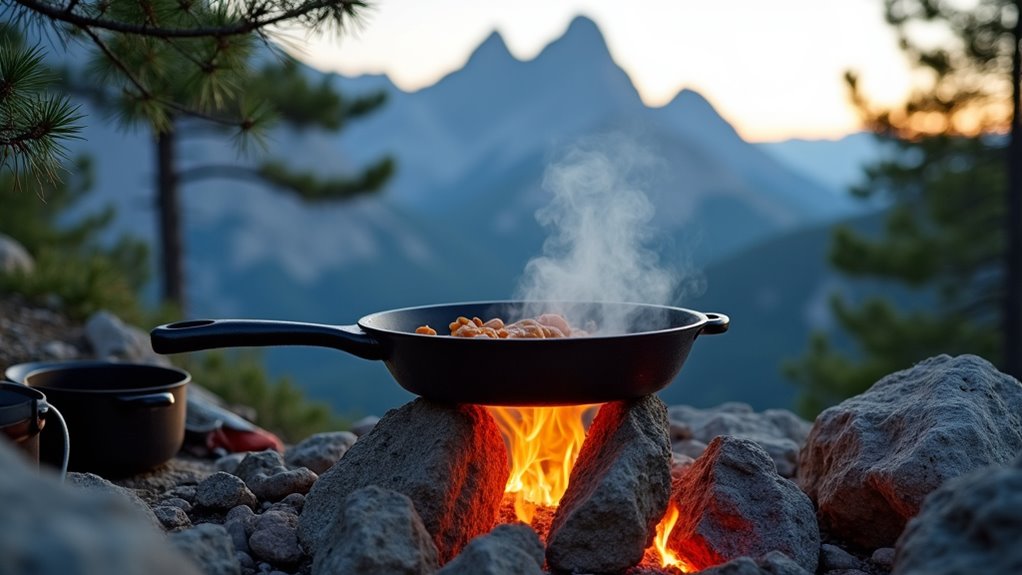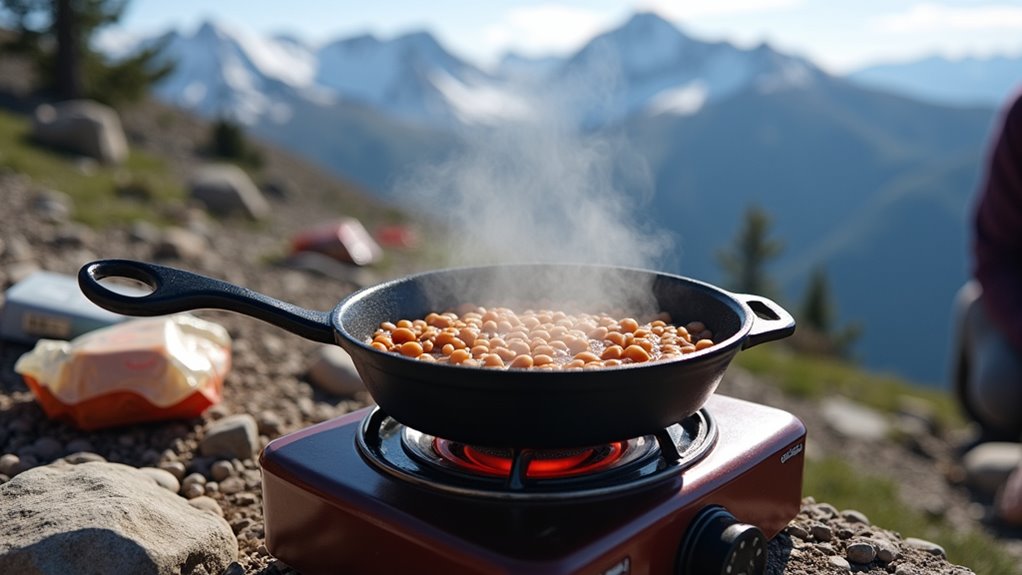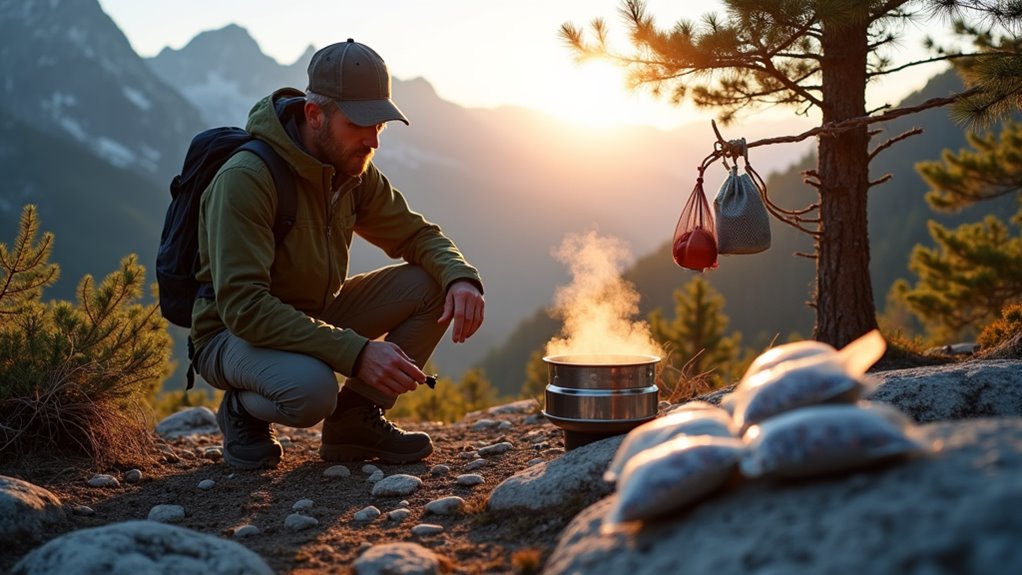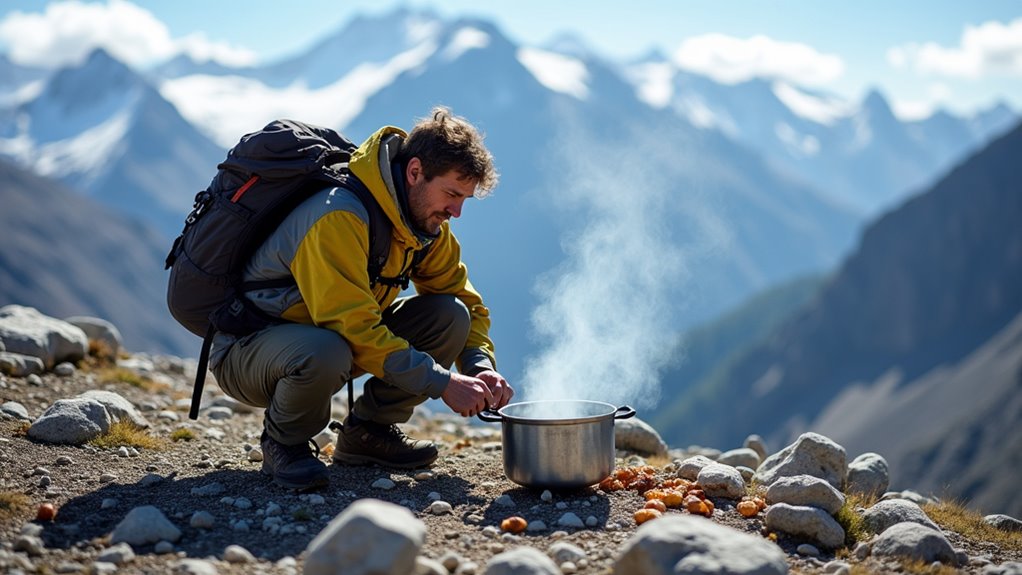Physical Address
304 North Cardinal St.
Dorchester Center, MA 02124
Physical Address
304 North Cardinal St.
Dorchester Center, MA 02124

Juggling altitude, weather, and finicky equipment turns mountain camping meals into epic battles that will test every outdoor cooking skill you thought you mastered.
You might think mountain cooking is just regular camping with a view, but you’ll quickly discover it’s an entirely different beast once you’re above the tree line. The thin air doesn’t just affect your breathing—it’ll turn your simple pasta dinner into a frustrating hour-long ordeal as water refuses to boil properly. Your trusty camp stove suddenly guzzles fuel like it’s going out of style, and that’s before the afternoon thunderstorm rolls in to complicate everything.

When you’re cooking above 3,000 feet, everything changes – and not always in ways you’d expect. Water boils at lower temperatures, meaning your pasta won’t cook properly and your coffee tastes weak. You’ll need to boil foods longer, which burns through precious fuel faster.
Baking becomes trickier too – your bread rises quicker but often collapses. Reduce leavening agents by 25% and increase liquid slightly. Rice and beans require extra water and cooking time, so plan accordingly.
Dehydration happens faster at altitude, affecting both you and your food. Items dry out quickly, so seal everything tightly. Your appetite might decrease initially, but don’t skip meals.
Pack simple, familiar recipes since experimenting with complex dishes often leads to disappointing results. If you’re planning extended camping trips, consider whether renting equipment makes more sense than purchasing items you’ll use infrequently.
Although altitude creates its own set of challenges, mountain weather throws even more curveballs at your camp kitchen. Wind’s your biggest enemy—it’ll extinguish flames, scatter ingredients, and make simple tasks frustrating. Pack a windscreen or cook behind natural barriers like rocks or trees.
Wind can turn a simple camping meal into a battle—pack windscreens and seek natural shelter behind rocks or trees.
Rain turns everything complicated. You can’t light fires easily, and wet gear becomes useless. Bring a tarp or lightweight canopy to create a dry cooking zone.
Cold weather drains fuel faster and makes cleanup harder with frozen water lines.
Snow adds weight to your shelter and limits fuel efficiency. Pack extra propane canisters and keep them warm in your sleeping bag overnight.
Hot weather spoils food quickly, so plan meals accordingly and store perishables in shaded, ventilated areas. Your sleeping bag becomes essential gear for protecting fuel canisters from temperature extremes during mountain cooking adventures.

Since mountain conditions demand reliable performance from every piece of equipment, you’ll want gear that multitasks and won’t fail when temperatures drop or winds pick up.
Prioritize a sturdy, wind-resistant stove with reliable ignition—canister stoves work well above treeline, while liquid fuel performs better in extreme cold.
Pack lightweight, nested cookware that doubles as serving bowls. A quality cooler or bear canister protects food while meeting regulations.
Don’t skimp on a sharp knife and cutting board—they’ll save time and frustration.
Bring extra fuel, matches, and a lighter as backups.
Consider a windscreen for your stove and pack everything in easy-access containers.
Smart gear choices prevent cooking disasters when you’re miles from the nearest store.
Before finalizing your pack, consider how much cookware to bring based on your group size, trip duration, and planned meals to avoid carrying unnecessary weight up the mountain.
While your gear gets you cooking, finding and purifying water becomes your next critical challenge in mountain environments. You’ll need to locate reliable water sources like streams, springs, or lakes while avoiding stagnant pools that harbor bacteria.
Boiling remains your most dependable purification method – just bring water to a rolling boil for one minute at sea level, adding an extra minute for every 3,000 feet of elevation.
Water purification tablets offer a lightweight, budget-friendly backup option, though they require 30-60 minutes to work effectively.
Portable water filters provide instant results but cost more upfront. Always carry backup purification methods since mountain weather can change quickly, potentially affecting your primary water source or purification equipment.
Having an essential survival kit with multiple water treatment options ensures you’re prepared for any mountain camping scenario where your primary purification method fails.

Once you’ve secured clean water, protecting your food from spoilage and wildlife becomes your next priority. Mountain temperatures fluctuate dramatically, making proper storage essential for food safety and your wallet.
Mountain temperature swings can destroy your food supply and budget—proper storage isn’t optional, it’s survival.
Your cooling options depend on natural resources. Bury perishables in snow or submerge sealed containers in cold streams. For dry storage, hang food bags at least 12 feet high and 4 feet from tree trunks to deter bears and rodents.
Essential storage strategies include:
You’ll save money and stay healthy by preventing spoilage. Remember that proper food storage is just one aspect of choosing the campsite that will ensure your mountain camping experience remains safe and enjoyable.
Although proper food storage helps minimize wildlife encounters, you’ll need additional safety measures to protect yourself and your cooking area from mountain animals.
Keep a clean campsite by washing dishes immediately and disposing of grease water at least 200 feet from camp. Cook and eat in designated areas, never near your tent. Make noise while cooking—talk loudly or clang pots to announce your presence.
If you encounter wildlife, don’t run. Back away slowly while making yourself appear larger.
Carry bear spray as an affordable deterrent, but know how to use it properly. Store it within easy reach while cooking.
Avoid cooking strong-smelling foods like bacon or fish that attract animals from miles away. Remember, prevention costs less than dealing with wildlife damage.
These practices align with low impact camping principles that emphasize minimizing your environmental footprint while ensuring safety in wilderness areas.

How does your body’s increased energy demand at elevation affect your meal planning strategy? At high altitudes, you’ll burn 300-500 extra calories daily while your appetite might decrease. This creates a nutritional puzzle that smart planning solves.
At high altitudes, your body burns 300-500 extra calories daily while appetite decreases—creating a challenging nutritional puzzle.
Focus on calorie-dense, easily digestible foods that won’t break your budget. Pack nuts, dried fruits, and energy bars for quick fuel. Your body craves carbohydrates at altitude, so don’t skimp on pasta, oats, and rice.
Essential high-altitude nutrition priorities:
Pre-portion meals at home to avoid overpacking expensive ingredients you won’t use.
When you’re cooking at 8,000 feet, your camp stove will guzzle fuel 25-30% faster than it does at sea level. That’s money burning away with every meal. Counter this byusing windscreens religiously – even light breezes steal heat and waste precious fuel.
Choose wide, shallow pots over tall, narrow ones since they heat faster and more evenly.
Keep lids on while cooking to trap heat and reduce cooking times. Pre-soak rice, beans, and pasta at home to cut boiling time in half. Pack a basic pot cozy made from reflective material to retain heat after you’ve turned off the stove.
Consider one-pot meals that minimize fuel use. Modern camping equipment innovations now include advanced heat exchangers and piezo ignition systems that can help maximize efficiency in challenging mountain conditions. These simple adjustments’ll stretch your fuel supply and keep your camping budget intact.

Even with careful fuel management, your primary stove can fail when you need it most – a clogged jet, broken igniter, or empty canister doesn’t care that you’re miles from the nearest gear shop.
That’s why you need backup cooking methods that won’t break the bank or weigh down your pack.
Essential emergency cooking options include:
A quality camping knife becomes indispensable for processing kindling, preparing food, and handling various camp tasks when your cooking equipment fails.
Practice using these alternatives before you need them. Your stomach will thank you when Plan A fails.
You’ve now mastered the essentials of mountain cooking, but here’s something that’ll motivate you: experienced mountain campers waste 40% less fuel than beginners by using these techniques. That’s real money saved on expensive camping fuel! Don’t let altitude and weather intimidate you—with proper gear selection, smart food planning, and backup methods, you’ll cook confidently at any elevation. Start practicing these skills on smaller trips before tackling major mountain adventures.